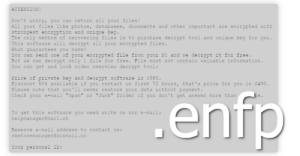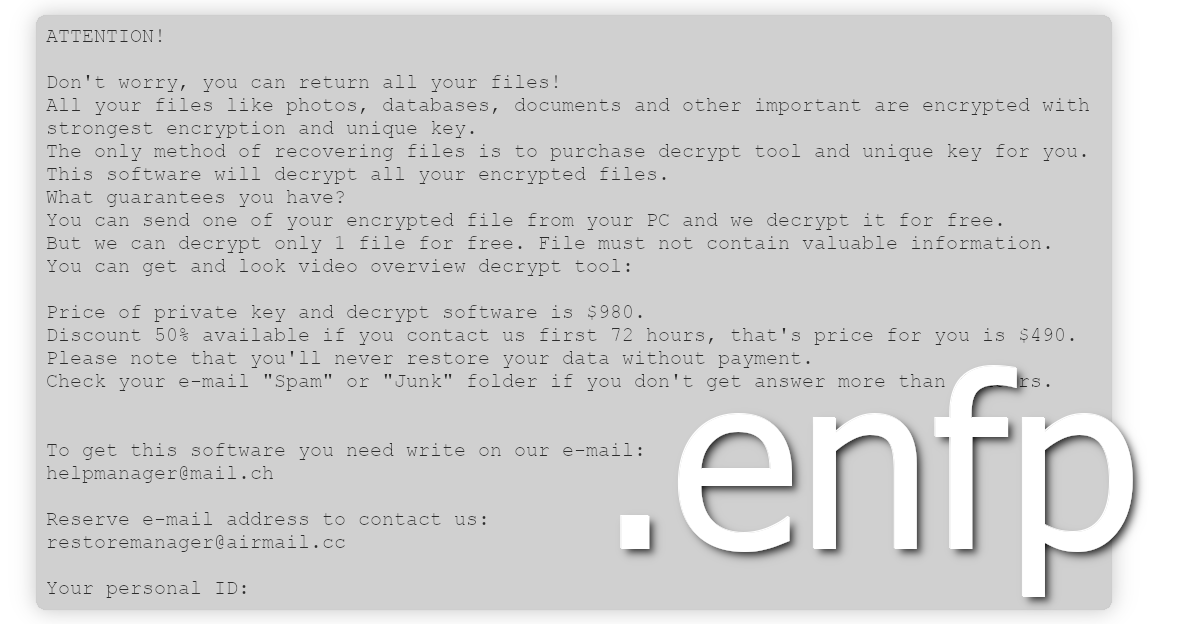Enfp is ransomware. It breaks your data and then demands that you pay hundreds of dollars to fix it. You can recognize Enfp by the new extension that it gives your files: “enfp”.
In addition to encrypted files, a few other problems come with Enfp malware. Additional malicious programs might be installed that steal information and cause excessive ads to be displayed. Enfp might also have a few important system settings changed.
Enfp Ransomware quicklinks
- What is Enfp ransomware?
- Enfp spreads on the internet
- It locks files and leaves ransom notes
- How to restore your data and delete Enfp
- Can you get your files back?
- How to delete Enfp ransomware
- Important -- edit the hosts file to unblock security websites
- Find and edit the hosts file
- Download and run the antivirus program
- Automatic Malware removal tools
- How to recover Enfp Ransomware encrypted files and remove the virus
- Step 1. Restore system into last known good state using system restore
- 1. Reboot your computer to Safe Mode with Command Prompt:
- 2.Restore System files and settings.
- Step 4. Use Data Recovery programs to recover Enfp Ransomware encrypted files

(Win)
Note: Spyhunter trial provides detection of parasites and assists in their removal for free. limited trial available, Terms of use, Privacy Policy, Uninstall Instructions,
(Mac)
Note: Combo Cleaner trial provides detection of parasites and assists in their removal for free. limited trial available, Terms of use, Privacy Policy, Uninstall Instructions, Refund Policy ,
Enfp ransomware:
| Malware type | Ransomware,
trojan. |
|---|---|
| Enfp ransomware infection symptoms | Files won’t open,
their names have been changed to end with “enfp”, notes demanding a ransom have been left behind. |
| Getting back the encrypted data | Restore data from a backup,
use file decryption tools, restore deleted files. |
| Enfp ransomware removal | Remove malware with antivirus tools (Spyhunter, others),
reset credentials for your online accounts. |
What is Enfp ransomware?
Enfp spreads on the internet
Enfp is one of many Djvu ransomware infections. Its name is just a meaningless set of letters, just like the names of its siblings Ribd, Cadq, and many others.
There are many ways for ransomware to spread, but Enfp almost certainly gets downloaded from the internet with pirated programs. It might arrive with “free” games, office installers, and other not-entirely-legitimate software.
Very likely, Enfp gets installed together with adware, password stealers, and other malicious programs.
It locks files and leaves ransom notes
Once Enfp is downloaded, you might notice your computer slow down. Enfp deletes backups and attempts to disable your antivirus protection. Then it goes through your drives and encrypts all the pictures, videos, documents, databases, and other data that it can find. It leaves some programs and your system files alone.
Enfp alters the names of the encrypted files to end with “enfp”.
It also creates files called “_readme.txt” that include a ransom demand from the people who made Enfp. These cybercriminals want from $490 to $980 in exchange for fixing your files. It’s recommended to stay away from them, even if you have the money to spare. There are too many bad stories of ransomware victims dealing with the extortionists:
- Victims being ignored by the criminals after they paid the ransom.
- New ransom demands being raised.
- Technical difficulties using the tools that the extortionists provided.
- Victims being remembered by the cybercriminals and them being targeted repeatedly.
You might be concerned about Enfp stealing your data. Some modern ransomware infections steal files from infected computers and threaten their victims to post those files publically. I’ve never heard of any Djvu variant doing that, so you probably don’t need to worry about that sort of blackmail.

How to restore your data and delete Enfp
Deleting Enfp ransomware won’t undo the harm that this malware has done by encrypting your files. So, getting back your data and deleting the malware are two separate things.
Can you get your files back?
Ransomware experts have already examined Djvu (which Enfp is a part of). Unfortunately, there is no way to fix the files encrypted by Enfp.
If you have backups of your data, then all you need to do is delete Enfp and replace all the encrypted files with those from your backup.
What if you don’t have a recent backup? There might be a few ways to still get some of your files back:
- Check the free decryptor (Emsisoft.com). It’s very unlikely to work, but it’s worth it to try.
- Scan your drives with a file recovery program (such as EaseUS). See if any files can be brought back.
- Look into file repairing services.
All these methods have limitations. It might be tempting to look for alternatives, but be careful. There are scammers out there who might make promises that they will not keep.
How to delete Enfp ransomware
Enfp is likely to spread together with spyware and adware infections. So, once all the malware is removed, it’s advisable to reset your passwords.
In order to remove the malware, you can use antivirus tools, such as Spyhunter, to find and delete Enfp and other malicious programs. The instructions can be found below. You might also need to fix your Task Manager and reset your hosts file to be able to use your computer normally again.
You could also just reset your Windows. Even then, you might still benefit from an antivirus scan.
Don’t forget to delete the file that caused the infection in the first place.
Important -- edit the hosts file to unblock security websites
TL DR : The hosts file is edited to block security sites Before the virus can be removed, it's necessary to fix the hosts file (the file which controls which addresses connect to which IPs). That is the reason the majority of security websites is inaccessible when infected with this particular parasite. This infection edits this file to stop certain websites, including anti-malware download sites, from being accessed from the infected computer, making browsers return the "This site can't be reached" error. Luckily, it's trivial to fix the file and remove the edits that were made to it.Find and edit the hosts file
The hosts file can be found on C:/Windows/System32/Drivers/etc/hosts. If you don't see it, change the settings to see hidden files.- In the Start Menu, search for Control Panel.
- In the Control Panel, find Appearance and Personalization.
- Select Folder Options.
- Open the View tab.
- Open Advanced settings.
- Select "Show hidden files...".
- Select OK.

- Open the Start Menu and enter "notepad".
- When Notepad shows up in the result, right-click on it.
- In the menu, choose "Run as administrator"
- File->Open and browse for the hosts file.
 Delete additional lines that they connect various domain names to the wrong IP address. Save the file.
Delete additional lines that they connect various domain names to the wrong IP address. Save the file.
Download and run the antivirus program
After that, download antivirus programs and use them to remove the ransomware, the trojan, and other malware. Spyhunter (https://www.2-viruses.com/reviews/spyhunter/dwnld/).Automatic Malware removal tools
(Win)
Note: Spyhunter trial provides detection of parasites and assists in their removal for free. limited trial available, Terms of use, Privacy Policy, Uninstall Instructions,
(Mac)
Note: Combo Cleaner trial provides detection of parasites and assists in their removal for free. limited trial available, Terms of use, Privacy Policy, Uninstall Instructions, Refund Policy ,
How to recover Enfp Ransomware encrypted files and remove the virus
Step 1. Restore system into last known good state using system restore
1. Reboot your computer to Safe Mode with Command Prompt:
for Windows 7 / Vista/ XP
- Start → Shutdown → Restart → OK.
- Press F8 key repeatedly until Advanced Boot Options window appears.
- Choose Safe Mode with Command Prompt.

for Windows 8 / 10
- Press Power at Windows login screen. Then press and hold Shift key and click Restart.

- Choose Troubleshoot → Advanced Options → Startup Settings and click Restart.
- When it loads, select Enable Safe Mode with Command Prompt from the list of Startup Settings.

2.Restore System files and settings.
- When Command Prompt mode loads, enter cd restore and press Enter.
- Then enter rstrui.exe and press Enter again.

- Click “Next” in the windows that appeared.

- Select one of the Restore Points that are available before Enfp Ransomware has infiltrated to your system and then click “Next”.

- To start System restore click “Yes”.

Step 2. Complete removal of Enfp Ransomware
After restoring your system, it is recommended to scan your computer with an anti-malware program, like Spyhunter and remove all malicious files related to Enfp Ransomware. You can check other tools here.Step 3. Restore Enfp Ransomware affected files using Shadow Volume Copies
If you do not use System Restore option on your operating system, there is a chance to use shadow copy snapshots. They store copies of your files that point of time when the system restore snapshot was created. Usually Enfp Ransomware tries to delete all possible Shadow Volume Copies, so this methods may not work on all computers. However, it may fail to do so. Shadow Volume Copies are only available with Windows XP Service Pack 2, Windows Vista, Windows 7, and Windows 8. There are two ways to retrieve your files via Shadow Volume Copy. You can do it using native Windows Previous Versions or via Shadow Explorer. a) Native Windows Previous Versions Right-click on an encrypted file and select Properties → Previous versions tab. Now you will see all available copies of that particular file and the time when it was stored in a Shadow Volume Copy. Choose the version of the file you want to retrieve and click Copy if you want to save it to some directory of your own, or Restore if you want to replace existing, encrypted file. If you want to see the content of file first, just click Open.
b) Shadow Explorer It is a program that can be found online for free. You can download either a full or a portable version of Shadow Explorer. Open the program. On the left top corner select the drive where the file you are looking for is a stored. You will see all folders on that drive. To retrieve a whole folder, right-click on it and select “Export”. Then choose where you want it to be stored.

Step 4. Use Data Recovery programs to recover Enfp Ransomware encrypted files
There are several data recovery programs that might recover encrypted files as well. This does not work in all cases but you can try this:- We suggest using another PC and connect the infected hard drive as slave. It is still possible to do this on infected PC though.
- Download a data recovery program.
- Install and scan for recently deleted files.








